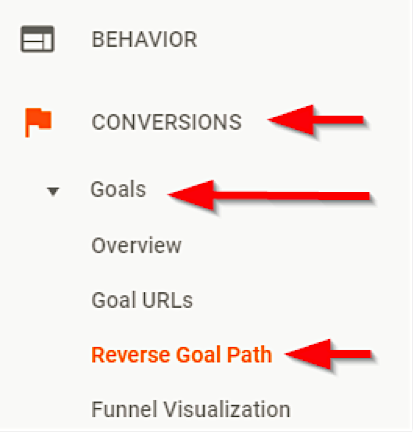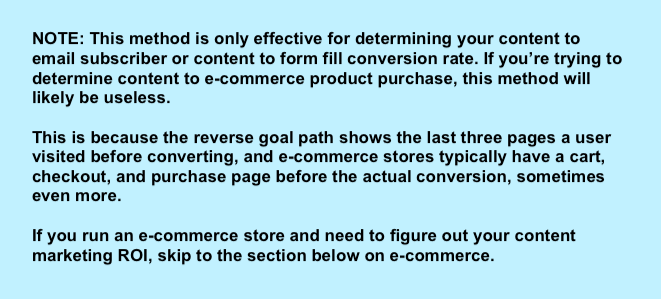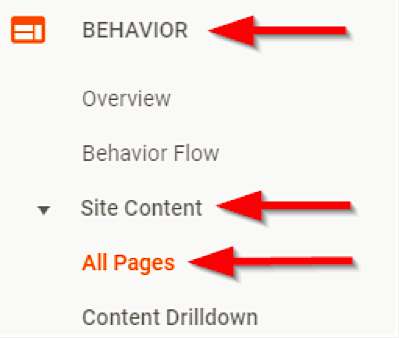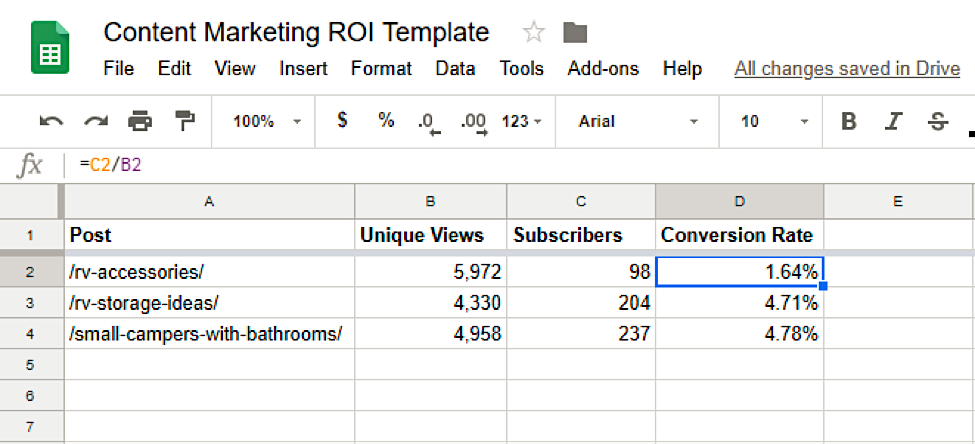Roughly 86% of marketers use content marketing to grow their business – yet 66% of them are not properly measuring their content marketing ROI:

Why?
Because it’s really damn hard. Content is nebulous. Sometimes a person will read a single article and immediately buy. Other times it takes 10 articles before someone’s ready to open their wallet. How can you track that?
Well, you can’t. At least not 100% accurately.
But you can get a rough estimate. And that’s far better than not measuring anything at all! If you know approximately how much traffic, leads and sales your articles are generating, you can use that data to continuously improve your marketing and plan your content strategy.
This guide will teach you how to measure your content marketing ROI using Google Analytics, step by step. But before that, there are some important things you should know.
Important Points Before You Begin
Content marketing has a lot of returns beyond direct leads or sales.
For example, having great content on your site can improve your customer retention which, in turn, increases your customer lifetime value. Plus, you could score links from top-tier publications who pick up on your research.
Great content can also help with brand awareness – just look at content marketing experts like Buffer, Neil Patel or HubSpot. Almost everyone in the marketing community knows these names because of the content they produce. How can you measure that kind of return?
Remember, your ROI is almost always higher than the value you’ll find by going through this process (because not everything is trackable).
Before you get started, I’m making a few assumptions…
- You have Google Analytics and goal tracking set up properly.
- You know how much an email subscriber is worth to you.
To figure that out, you need two equations.
First, take your total number of subscribers (# Subs), multiply that by your conversion rate (CVR) and multiply that by your Average Order Value (AOV) to find your total profit from your list:
# Subs (CRV) (AOV) = Total Profit
Then, divide your profit by your total number of subscribers to find the value of a single email subscriber:
Profit ÷ # Subs = Value of an Email Subscriber
For example, if I get one sale for every 10 subscribers (10% conversion rate) and the average order value from that sale is $10, then every subscriber I get is worth roughly $1.
10 subs (0.1) ($10) = $10 profit
$10 profit ÷ 10 subs = $1 per lead
That’s all there is to it! Now, let’s move on to Google Analytics.
5 Steps to Measure Content Marketing ROI via Goal Conversions
Head over to your Analytics account and follow along.
Step 1: Determine Your Costs
To know your return, you have to know how much you’ve spent. This step is simple – just add up all the costs of creating, promoting, and building links to your content.
For example, if I hired a writer to create an article and it cost me $500, and I also spent $200 on paid promotion for that article, I’d be at $700 cost per article.
If I then spend two hours on email outreach to further promote and build links to that article, that’s a cost, too. To determine a dollar amount, simply multiply your billable rate by the number of hours you spent promoting the article. So, if you bill $150 per hour, you just added $300 to the cost of that article, for a total of $1,000.
Further Reading:
- The Beginner’s Guide to Creating a Content Marketing Strategy
- Creating Google Analytics Funnels and Goals: A Step-by-Step Guide
- The Ultimate Guide to Link Building with Content
Step 2: Download Your Reverse Goal Path Data
Now we’re getting into Google Analytics. Go to Conversions » Goals » Reverse Goal Path.


Now, once you’ve got your reverse goal path data, export it to a CSV file by clicking the “Export” button at the top of the page. We’re going to put it in a Google Sheet along with your page view data, which you’ll retrieve in Step 3 below.

Step 3: Download Your Page View Data
Next, go to Behavior » Site Content » All Pages.

Filter your content to only show blog posts by typing “/blog” in the search bar. If you don’t have “/blog” in your blog post URLs, you’ll need to filter through them manually. Download this data into a CSV file just like you did in Step 2.
Step 4: Calculate Your Conversion Rate & Profit
Finally, take the two CSV files you’ve downloaded and merge them into a single Google Sheet. Create four columns:
- Post
- Unique Views
- Subscribers
- Conversion Rate
NOTE: If you’re using form fills or another action as your Google Analytics Goal conversions, change the name of that column to reflect this. For example, this column could say “Leads” or “Form Fills”.
Next, divide column C (Subscribers) by Column B (Unique Views) and multiply it by 100 to get your Conversion Rate (Column D). When you’re done, it should look like this:

You can now see which articles on your site are giving you the highest return in terms of goal conversions. But we’re not done yet!
PRO TIP: If you have a very low conversion rate, your landing page could be the culprit. Consider improving your product page design to increase conversions and squeeze more profits from your content marketing efforts.
Further Reading:
- 5 Ways to Track Your Website’s Revenue with Google Analytics
- How to Use Predictive Analytics for Better Marketing Performance
- How to Use Big Data Analytics to Grow Your Marketing ROI
Step 5: Calculate Your ROI
Add a fifth column to your Google Sheet titled “Profit”. Multiply column C (Subscribers) by your unique subscriber value calculated in the first section of this guide.
Using the $1 example we calculated, here’s what mine would look like:

Now you can see the direct profit from each article for the given time frame! If you want to see for a full year, change the data in Analytics to reflect that and re-do this process. You can even create a separate sheet for weekly, monthly, quarterly, and yearly return.
But this is still just profit. What about return? For that, we’ll have to create two additional columns:
- Cost
- ROI
The cost column is the total cost of the article, including creation, promotion, and link building. The ROI column is the profit column minus the cost column. Here’s what that looks like:

Boom! You now have exact dollar amounts to measure your content marketing ROI with Google Analytics and a spreadsheet.
But that’s just ROI from your email subscribers (or whatever goal conversions you’ve set up) based on averages. What about direct sales?
Calculating ROI From Content Marketing Via Direct Sales
For this section, you need to have e-commerce goal tracking turned on and set up. If that’s set up properly, you should be able to see your page value from each page on your site by going to Behavior » Site Content » All Pages just like we did in Step 3 above.

However, this only tracks sales for single sessions. As I said above, not everyone will visit a single article and immediately buy. Some will come back again and again before finally making a purchase from you.
That’s where Assisted Conversions come in.
Assisted Conversions measure the number of conversions that a channel (such as paid ads or organic search) assisted with, at any point along the customer’s journey.
To see Assisted Conversions, go to Conversions » Multi-Channel Funnels » Assisted Conversions. Click on a channel and look at the Lead or Click Direct Conversion Value column to see how much money a post has made via direct and indirect sources.

You can dive into these reports to see which channels are driving the most sales. For example, if Pinterest tends to be the biggest assistor to your content, spend more time getting into high-quality Pinterest groups.
Or, if Google is your biggest revenue driver, put your efforts behind improving your SEO and guest posting. You get the idea.
Further Reading:
- How to Run A/B Tests that Actually Increase Conversions
- The 10 Most Powerful SEO Tactics for 2018
- How to Implement a Cost-Effective SEO Strategy in 4 Steps
Bonus Tip For More Accurate Tracking & More Sales
For content marketing to be truly effective, at least some (if not most) of your articles need to be purely informational to teach your readers something. That means not all of your articles will directly promote your products/services.
But you can still translate these visitors directly into leads/sales!
The key is native advertising – ads for your products or services that fit seamlessly into your content, typically in the form of in-line ads with a CTA.
For example, Neil Patel puts customer testimonials in the middle of his articles with a button to contact him and help grow your company:

You can also do this for e-commerce products. For example, we interviewed 20 camping experts to figure out their favorite camping gear. In between their answers, we created standout boxes to advertise our new travel-related T-shirts:

By adding native ads like these, you can see exactly which articles are converting into sales (and how much money they’re making you) with a simple goal funnel. To see the results from this, you have two options:
- Create a unique goal conversion in Google Analytics for these native ads, then create a goal funnel that goes from the native ad button through to the sale. From there, you’ll be able to see which articles drove the most goal conversions via that funnel under the Conversions » Goals » Goal Flow section.
- Use a heat mapping tool like Crazy Egg to see which articles receive the most clicks on a particular native ad. This method is easier to implement, but less accurate (since it doesn’t factor in actual conversions).

You can also run A/B tests on your native ads to further improve your click-through rate. Yes, there’s always more to be done!
Transforming Your Content Marketing Strategy
Armed with this knowledge, you now have a way to measure your content marketing ROI in a concrete dollar amount.
While this method isn’t 100% accurate, it is very simple and easy to implement. And you can use this data to:
- Determine which articles to spend more money or time promoting.
- Create more of the articles/topics that tend to drive the most revenue.
- Stop wasting time on content that simply isn’t performing.
Whether you’re an e-commerce store owner or you provide a service, tracking your content marketing efforts is an easy way to get more sales. So get to it!


